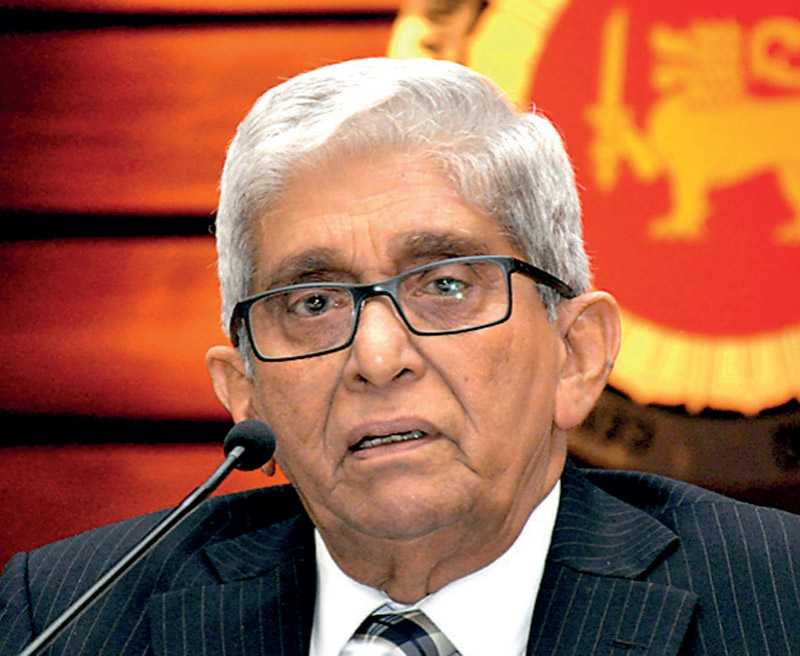Monday Apr 07, 2025
Monday Apr 07, 2025
Friday, 5 March 2021 03:04 - - {{hitsCtrl.values.hits}}

CB Governor Prof. W.D. Lakshman – Pic by Lasantha Kumara
By Uditha Jayasinghe
The Central Bank (CB) yesterday kept policy rates steady to support economic revival and outlined plans to direct as much as 20% of the Rs. 850 billion private sector credit growth expected in 2021, to Micro, Small and Medium Enterprises (MSMEs) to boost growth.
CB Governor Prof. W.D. Lakshman told reporters that even though policy rates had reduced interest rates to historic levels and the monetary authority was focused on keeping rates static, steps would be taken in the coming weeks to set lending targets to key industries. The CB has set a first quarter growth target of 3-3.5%.
He noted that the Government had already held talks with a range of sectors, including apparel, tea, rubber, coconut, gem and jewellery, tourism and IT to identify industry-specific challenges. Prof. Lakshman assured concerns would be expeditiously addressed with the involvement of top Government officials.
He also said discussions were ongoing with banks to see whether the moratorium could be extended a third time. However, CB officials conceded this could be challenging as banks were also struggling to maintain strong balance sheets, creating difficulties in having an umbrella approach. Some industries, such as tourism, may be given an extension, while others would be covered selectively.
“We need a revival to first take the economy out of the COVID-19 condition and then work towards the growth of the economy. Other conditions are needed to boost investment, but the main policy instrument is the low-interest regime and market liquidity for banks that is being provided, and trusting the banks to increase their lending to productive segments of the economy,” the Governor said.
The Monetary Board, at its latest meeting, had paid attention to two key requirements, namely increasing bank lending to high inflow generating sectors and others that have potential but still underfunded. Despite the prevalence of low rates, the Governor acknowledged that an uptick in the rates of Government securities was not in line with policy rates, but that the CB will continue to issue directions prior to auction to manage rates.
“Although we do not expect a further decline in market interest rates at this time, we certainly do not expect them to increase either in the near future,” he stated, adding “This is not an easy period to manage, but we will do what is necessary for the country to achieve sustained growth and prosperity.”
The Governor reiterated the goal of moving towards a current account surplus that would enable stronger reserves while reducing reliance on debt. He also mentioned that talks on $ 2.5 billion worth of swap arrangements with China and India were ongoing, but declined to give details beyond describing discussions as “positive.”
The trade deficit contracted by $ 2 billion in 2020, benefiting from the notable decline in expenditure on imports, which more than compensated the decline in earnings from exports. The trade deficit is expected to remain compressed in 2021, supported by appropriate measures taken by the Government, officials said.
The CB is also hoping to absorb $ 125 million monthly from remittances and new regulations on export earning conversions this year. Reserves have already been boosted $ 28 million from remittances and $ 8 million from export conversions.
Workers’ remittances continued to increase steadily from mid-2020, recording an annual increase of 5.8%, and a further growth of 16.3% in January 2021, from a year earlier. The tourism sector is expected to gradually recover in 2021 along with the rollout of vaccinations locally and globally.
The exchange rate has recorded intermittent volatility, and the CB has taken steps to dampen excessive speculation causing such volatility in the foreign exchange market. The Sri Lankan rupee has depreciated by 4.5% against the US dollar thus far in 2021, following the 2.6% depreciation in 2020. Gross official reserves were estimated at $ 4.8 billion, with an import cover of 3.7 months, at the end of January 2021.
Both headline and core inflation based on consumer price indices remain low, reflecting the subdued aggregate demand conditions in the economy, despite volatile food prices. Inflation is projected to remain subdued during the remainder of the year supported by the envisaged improvements in domestic supply conditions, which would also contribute towards maintaining inflation in the targeted range of 4%-6% over the medium-term.